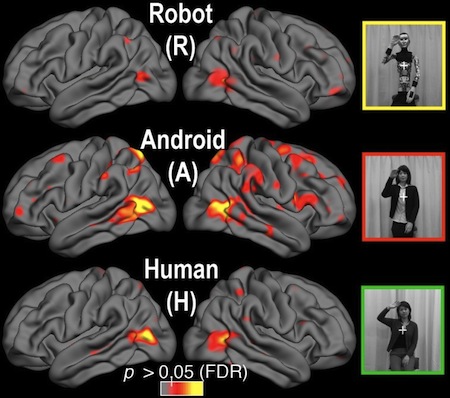Science Fiction
Dictionary
A B C D E F G H I J K L M N O P Q R S T U V W X Y Z
Brain Scans Reveal 'Uncanny Valley'

In 1970, Japanese roboticist Masahiro Mori remarked in 1970 that, as robots become more humanlike in appearance, people will respond more positively. However, a point will be reached where people will be strongly repulsed; acceptance will fall. This uncanny valley (seen if you plot acceptance versus increasingly humanoid appearance), is of great concern to those who would like to see humanoid robots play a greater role in our daily lives.
In a recent study conducted by Ayse Pinar Saygin, an assistant professor of cognitive science at the University of California, San Diego, twenty test subjects were shown videos of the Repliee Q2 android.
As they did so, their brains were scanned using a functional magnetic resonance imaging (fMRI) scanner, which revealed significant differences in the way they viewed the android, a metallic robot and a person.

(Brain response revealed)
When viewed through a functional magnetic resonance imaging (fMRI) scanner, the activity of the subjects' brains suggested that a conflict arose when they were viewing the footage of the lifelike version of the android. More specifically, activity was noted in their parietal cortex, which connects the part of the brain that processes body movements with a section of the motor cortex that is believed to help us relate to such movements. In short, Saygin believed that there was a disconcerting difference between the way in which the test subjects expected the android to move, and the way in which it did move."The brain doesn't seem tuned to care about either biological appearance or biological motion per se," she said. "What it seems to be doing is looking for its expectations to be met - for appearance and motion to be congruent." She added that perhaps androids and lifelike animated film characters should be run past human volunteers while still in development, to see what kind of response they elicit.
Take a look at this video showing the HRP-4C robot dancing to encounter the uncanny valley yourself. (Find out more at Dancing HRP-4C Robot Uncanny Valley Girl.)
( HRP-4C Female cybernetic humanoid dancer)
Via Gizmag.
Scroll down for more stories in the same category. (Story submitted 7/20/2011)
Follow this kind of news @Technovelgy.| Email | RSS | Blog It | Stumble | del.icio.us | Digg | Reddit |
Would
you like to contribute a story tip?
It's easy:
Get the URL of the story, and the related sf author, and add
it here.
Comment/Join discussion ( 3 )
Related News Stories - (" Robotics ")
Artificial Skin For Robots Is Coming Right Along
'... an elastic, tinted material that had all the feel and appearance of human flesh and epidermis.' - Harl Vincent (1934)
Robot Guard Dog On Duty
I might also be thinking of K-9 from Doctor Who.
Wearable Artificial Fabric Muscles
'It is remarkable that the long leverages of their machines are in most cases actuated by a sort of sham musculature...' HG Wells, 1898.
Dancing Robots Taught Dance Moves
'A clockwork figure would be the thing for you...' Jerome K. Jerome, 1893.
Technovelgy (that's tech-novel-gee!) is devoted to the creative science inventions and ideas of sf authors. Look for the Invention Category that interests you, the Glossary, the Invention Timeline, or see what's New.
Science Fiction
Timeline
1600-1899
1900-1939
1940's 1950's
1960's 1970's
1980's 1990's
2000's 2010's
Current News
Replace The Smartphone With A Connected Edge Node For AI Inference
'Buy a Little Dingbat... electropen, wrist watch, pocketphone, pocket radio, billfold ... all in one.'
Artificial Skin For Robots Is Coming Right Along
'... an elastic, tinted material that had all the feel and appearance of human flesh and epidermis.'
Robot Guard Dog On Duty
I might also be thinking of K-9 from Doctor Who.
Wearable Artificial Fabric Muscles
'It is remarkable that the long leverages of their machines are in most cases actuated by a sort of sham musculature...'
BrainBridge Concept Transplant Of Human Head Proposed
'Briquet’s head seemed to think that to find and attach a new body to her head was as easy as to fit and sew a new dress.'
Google's Nano Banana Pro Presents Handwritten Math Solutions
'...copy was turned out in a charming and entirely feminine handwriting.'
Edible Meat-Like Fungus Like Barbara Hambly's Slunch?
'It was almost unheard of for slunch to spread that fast...'
Sunday Robotics 'Memo' Bot Has Unique Training Glove
'He then started hand movements of definite pattern...'
Woman Marries Computer, Vonnegut's Dream Comes True
'Men are made of protoplasm... Lasts forever.'
Natural Gait With Prosthetic Connected To Nervous System
'The leg was to function, in a way, as a servo-mechanism operated by Larry’s brain...'
Spidery 'Walk Me' Toyota Autonomous Wheel Chair Like Star Wars
Walk along with the emperor.
Dancing Robots Taught Dance Moves
'A clockwork figure would be the thing for you...'
Proof Of Robothood - Not A Person
'Who are you people? - Show 'em.'
Indonesian Clans Battle
'The observation vehicle was of that peculiar variety used in conveying a large number of people across rough terrain.'
The 'Last Mile' In China Crowded With Delivery Robots
Yes, it's a delivery robot. On wheels.
Tornyol Microdrone Kills Mosquitoes
'The real border was defended by... a swarm of quasi-independent aerostats.'
